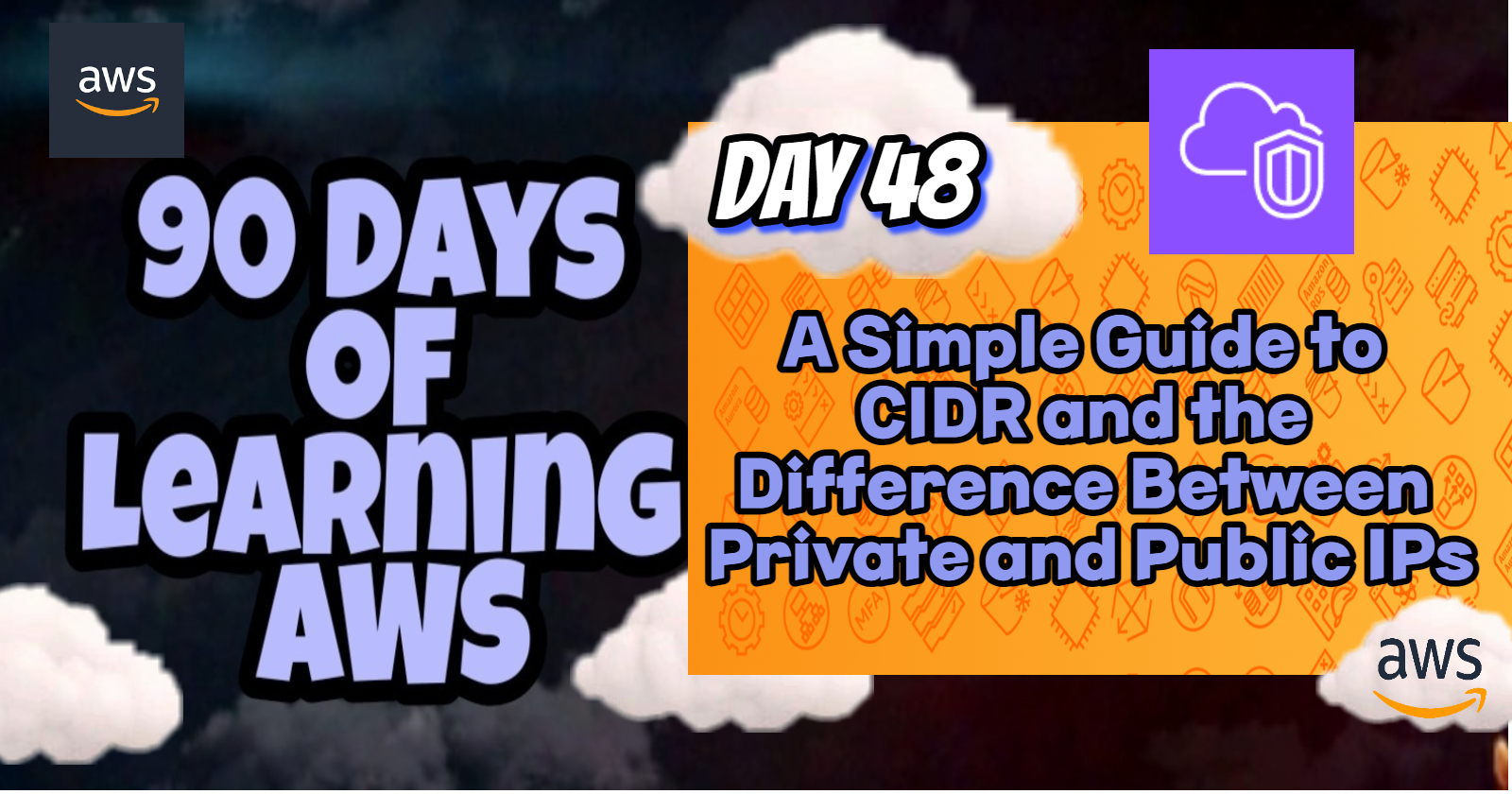A Simple Guide to CIDR and the Difference Between Private and Public IPs
 Shailesh
Shailesh
Introduction
In the world of networking, especially when working with cloud services like AWS, understanding the concepts of CIDR (Classless Inter-Domain Routing), and the differences between private and public IP addresses is crucial. These concepts form the backbone of network configuration and management, ensuring efficient and secure communication between devices. In this blog post, we'll explore CIDR, Public IP and Private IP in detail.
CIDR (Classless Inter-Domain Routing)
🟠What is CIDR? Classless Inter-Domain Routing (CIDR) is a method for allocating IP addresses and IP routing that replaces the old system based on classes A, B, and C. Introduced in 1993 to improve IPv4 address allocation efficiency, CIDR is now a standard IP address notation method used in modern networking.
🟠CIDR Notation CIDR notation includes an IP address followed by a slash (/) and a number. The number represents the number of bits in the network prefix. For example:
192.168.1.0/24represents a network with 256 IP addresses (192.168.1.0 to 192.168.1.255).10.0.0.0/16represents a network with 65,536 IP addresses (10.0.0.0 to 10.0.255.255).
🟠Benefits of CIDR
Efficient IP Address Allocation: CIDR allows for the aggregation of IP addresses into blocks, reducing the wastage of IP addresses.
Scalability: It supports more flexible and scalable network designs.
Improved Routing Efficiency: CIDR reduces the size of routing tables, which can improve the speed and performance of routers.
🟠CIDR in AWS: In AWS, when creating a VPC (Virtual Private Cloud), you define a CIDR block to specify the range of IP addresses that the VPC can use. This CIDR block must be within the private IP range and ensures that your network can scale and manage IP addresses efficiently.
Private IP vs. Public IP
💠Private IP Addresses
Definition: Private IP addresses are used within a private network and are not routable on the public internet. These addresses are used for communication within a network, such as a VPC in AWS.
Ranges: Private IP addresses fall within specific ranges defined by the Internet Assigned Numbers Authority (IANA):
10.0.0.0 - 10.255.255.255(10/8 prefix)172.16.0.0 - 172.31.255.255(172.16/12 prefix)192.168.0.0 - 192.168.255.255(192.168/16 prefix)
Use Case in AWS: Instances within a VPC typically have private IP addresses for internal communication, ensuring secure and isolated networking.
💠Public IP Addresses
Definition: Public IP addresses are routable on the public internet, allowing devices to communicate with external networks and services.
Allocation: These addresses are assigned by the Internet Service Provider (ISP) and must be unique across the internet.
Use Case in AWS: When an instance in a VPC needs to be accessible from the internet, it can be assigned a public IP address. This allows services running on the instance to be accessed externally.
💠Key Differences Between Private and Public IP Addresses
Accessibility: Private IP addresses are limited to internal network communication, whereas public IP addresses enable internet communication.
Security: Private IP addresses enhance security by isolating internal network traffic, while public IP addresses expose services to the public, requiring robust security measures.
Usage: Private IP addresses are used for internal resources like databases and application servers. Public IP addresses are used for resources that need to be accessed externally, such as web servers.
💠Practical Example in AWS
Scenario: You have a web application hosted on AWS, consisting of a web server and a database server.
Web Server (Public IP)
The web server needs to be accessible over the internet.
It is assigned a public IP address, enabling users to access the application via a web browser.
Database Server (Private IP)
The database server should not be directly accessible from the internet for security reasons.
It is assigned a private IP address, allowing only internal communication within the VPC.
Communication Setup
The web server communicates with the database server using its private IP address.
Security groups and network ACLs (Access Control Lists) are configured to allow traffic between the web server and database server while blocking unauthorized access.
Conclusion💡
Understanding CIDR and the distinction between private and public IP addresses is fundamental for designing and managing networks in AWS. CIDR enables efficient IP address allocation and routing, while the use of private and public IP addresses ensures secure and appropriate network accessibility. These concepts are vital for setting up scalable and secure network environments in AWS.
Stay tuned for more AWS insights!!⚜ If you found this blog helpful, share it with your network! 🌐😊
Happy cloud computing! ☁️🚀
Subscribe to my newsletter
Read articles from Shailesh directly inside your inbox. Subscribe to the newsletter, and don't miss out.
Written by

Shailesh
Shailesh
As a Solution Architect, I am responsible for designing and implementing scalable, secure, and efficient IT solutions. My key responsibilities include: 🔸Analysing business requirements and translating them into technical solutions. 🔸Developing comprehensive architectural plans to meet organizational goals. 🔸Ensuring seamless integration of new technologies with existing systems. 🔸Overseeing the implementation of projects to ensure alignment with design. 🔸Providing technical leadership and guidance to development teams. 🔸Conducting performance assessments and optimizing solutions for efficiency. 🔸Maintaining a keen focus on security, compliance, and best practices. Actively exploring new technologies and continuously refining strategies to drive innovation and excellence.